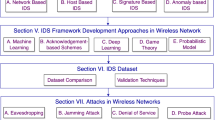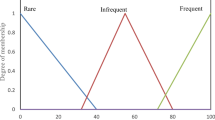Abstract
In mobile ad hoc networks for big data transmission, nodes communicate with each other via intermediate nodes. However, some intermediate nodes may behave selfishly, resulting in reduced throughput and increased delay in the network. Thus, the existence of selfish behaviour in a mobile ad hoc network degrades the performance of the network. In this paper, we propose a scheme that detects selfish behaviour and prevents its occurrence in mobile ad hoc network. The proposed scheme uses an adaptive threshold algorithm to detect selfish behaviour, and prevents it based on a repeated games scheme. Extensive simulations using NS-2 showed that our scheme can effectively detect and prevent selfish behaviour.



Similar content being viewed by others
References
Sun B, Osborne L, Xiao Y, Guizani S (2007) Intrusion detection techniques in mobile ad hoc and wireless sensor networks. IEEE Wirel Commun 14:56–63
Yokoyama S, Nakane Y, Takahashi O, Miyamoto E (2006) Evaluation of the impact of selfish nodes in ad hoc networks and detection and countermeasure methods. In: 7th international conference on mobile data management, (MDM 2006), pp 95–100
Padiya S, Pandit R, Patel S (2013) Survey of Innovated Techniques to detect selfish nodes in MANET. In: International journal of computer networking, wireless and mobile communications (IJCNWMC), pp 2250–1568
Rodriguez-Mayol A, Gozalvez J (2013) Reputation based selfishness prevention techniques for mobile ad-hoc networks. Springer Telecommunication Systems, pp 1–15
Buttyán L, Hubaux J-P (2003) Stimulating cooperation in self-organizing mobile ad hoc networks. Mob Netw Appl 8:579–592
Zhong S, Chen J, Yang YR (2003) Sprite: a simple, cheat-proof, credit-based system for mobile ad-hoc networks. In: 2003 IEEE 22th international conference on computer communication (INFOCOM 2003), pp 1987–1997
Yoo Y, Agrawal DP (2006) Why does it pay to be selfish in a MANET? IEEE Wirel Commun 13:87–97
Marti S, Giuli TJ, Lai K, Baker M (2000) Mitigating routing misbehavior in mobile ad hoc networks. In: 2000 ACM 6 th annual international conference on mobile computing and networking, pp 255–265
He Q, Wu D, Khosla P (2004) SORI: a secure and objective reputation-based incentive scheme for ad-hoc networks. In: 2004 IEEE conference on wireless communications and networking (WCNC 2004), vol 2, pp 825–830
Srivastava V, Neel JO, MacKenzie AB, Menon R, DaSilva LA, Hicks JE et al (2005) Using game theory to analyze wireless ad hoc networks. IEEE Commun Surv Tutor 7:46–56
Pandana C, Han Z, Liu KR (2008) Cooperation enforcement and learning for optimizing packet forwarding in autonomous wireless networks. IEEE Trans Wirel Commun 7:3150–3163
Han Z, Poor HV (2009) Coalition games with cooperative transmission: a cure for the curse of boundary nodes in selfish packet-forwarding wireless networks. IEEE Trans Commun 57:203–213
Debjit D, Majumder K, Dasgupta A (2015) Selfish node detection and low cost data transmission in MANET using game theory. Procedia Computer Sci 54:92–101
Tao L, Ming-Sen X (2012) Research of avoid the selfish behavior in mobile ad hoc networks based on repeated game. In: 2012 4th international conference on multimedia information networking and security (MINES 2012), pp 835–838
Siris VA, Papagalou F (2006) Application of anomaly detection algorithms for detecting SYN flooding attacks. Computer Commun 29:1433–1442
Mailath GJ, Samuelson L (2006) Repeated games and reputations: long-run relationships. OUP Catalogue
Yu-rui LIN (2008) Application of desired utility function theory to library administration. College Math 2:039
Bettstetter C, Resta G, Santi P (2003) The node distribution of the random waypoint mobility model for wireless ad hoc networks. IEEE Trans Mob Comput 2:257–269
Acknowledgments
This work is supported by the National Natural Science Foundation of China under Grant No. 61202435 and 61272521 and the Natural Science Foundation of Beijing under Grant No. 4132048.
Author information
Authors and Affiliations
Corresponding author
Rights and permissions
About this article
Cite this article
Lei, T., Wang, S., Li, J. et al. Detecting and preventing selfish behaviour in mobile ad hoc network. J Supercomput 72, 3156–3168 (2016). https://doi.org/10.1007/s11227-015-1561-2
Published:
Issue Date:
DOI: https://doi.org/10.1007/s11227-015-1561-2




